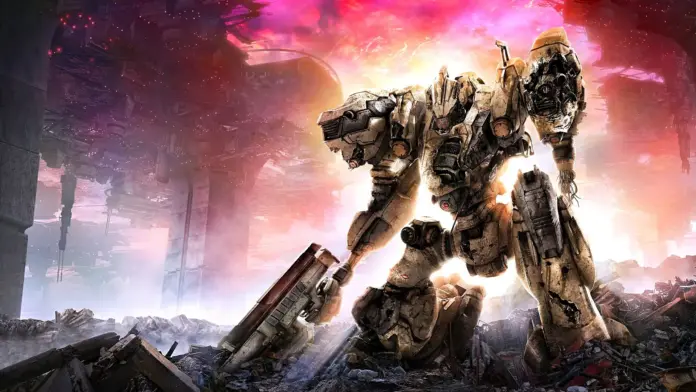FromSoftware turns its back on the Souls genre and goes back to the Armored Core series. The sixth installment puts you in a mech and promptly sends you into the action. And it’s a tough one.
A giant mech on four legs plummets from the sky to the ground. In its right arm it carries an oversized shotgun, in its right a bazooka. From its back protrude rocket launchers and a long-barreled laser weapon. In battle against many other smaller mechs, he whirls around and destroys them in a matter of seconds.
Surrounded by explosions, he stands there, enveloped in fire and smoke from his enemies. And best of all, this super-powered mech is pink. With light blue stars. And purple stripes. Because my mech – or Armored Core, as the game calls its fighting machines – has to stand out visually from the mass of grey-silver steel. Armored Core 6: Fires of Rubicon gives me the opportunity to do that. And although I’ve had my little difficulties with the game, it’s one of the highlights of the year for me so far.
We all know FromSoftware for Bloodborne, Sekiro, Elden Ring and especially their Dark Souls series. The latter in particular has made a name for the studio in gaming history and caused quite a stir. But to say one thing right away: If you expect such a game, you will be disappointed.
Although the name FromSoftware is on Armored Core 6: Fires of Rubicon, you will neither get a Souls-like nor a second Elden Ring. But you will get a game that sets its own accents. Instead of a mage, bandit or knight, you are now the pilot of an Armored Core, which can be hired as a mercenary by different factions.
As Armored Core 621 you reach the eponymous planet Rubicon at the beginning, where a fierce battle for the resource Coral has broken out. What this is remains unclear for a long time. With this, Armored Core 6: Fires of Rubicon also signals right from the start that the story is only secondary. The gameplay is in the foreground and that is something to be proud of.
Table of Contents
Small steps, big leaps
No sooner have you piloted your Armored Core for the first time than various groups will approach you with orders. These bring you money for the shop (more on this later) and vary in difficulty. However, you cannot choose which faction you prefer to join. Instead, each mission must be accepted.
You will meet, among others, the corporations that exploit the planet for the Coral, the Rubicon Liberation Front and private mercenary companies. On the one hand, this structure is somewhat superficial, but on the other hand it is pleasantly simple, as you don’t have to spend a lot of time thinking about the choice of mission. Later on you get the chance to decide where to go, but until then it remains simple.
What is less simple, however, is the gameplay This starts with such basic things as movement. You start in a small mech and learn to navigate your machine. If you only press the analogue stick forward, your Armored Core slowly trudges along and is more reminiscent of the domestic vacuum robot than a fighting machine.
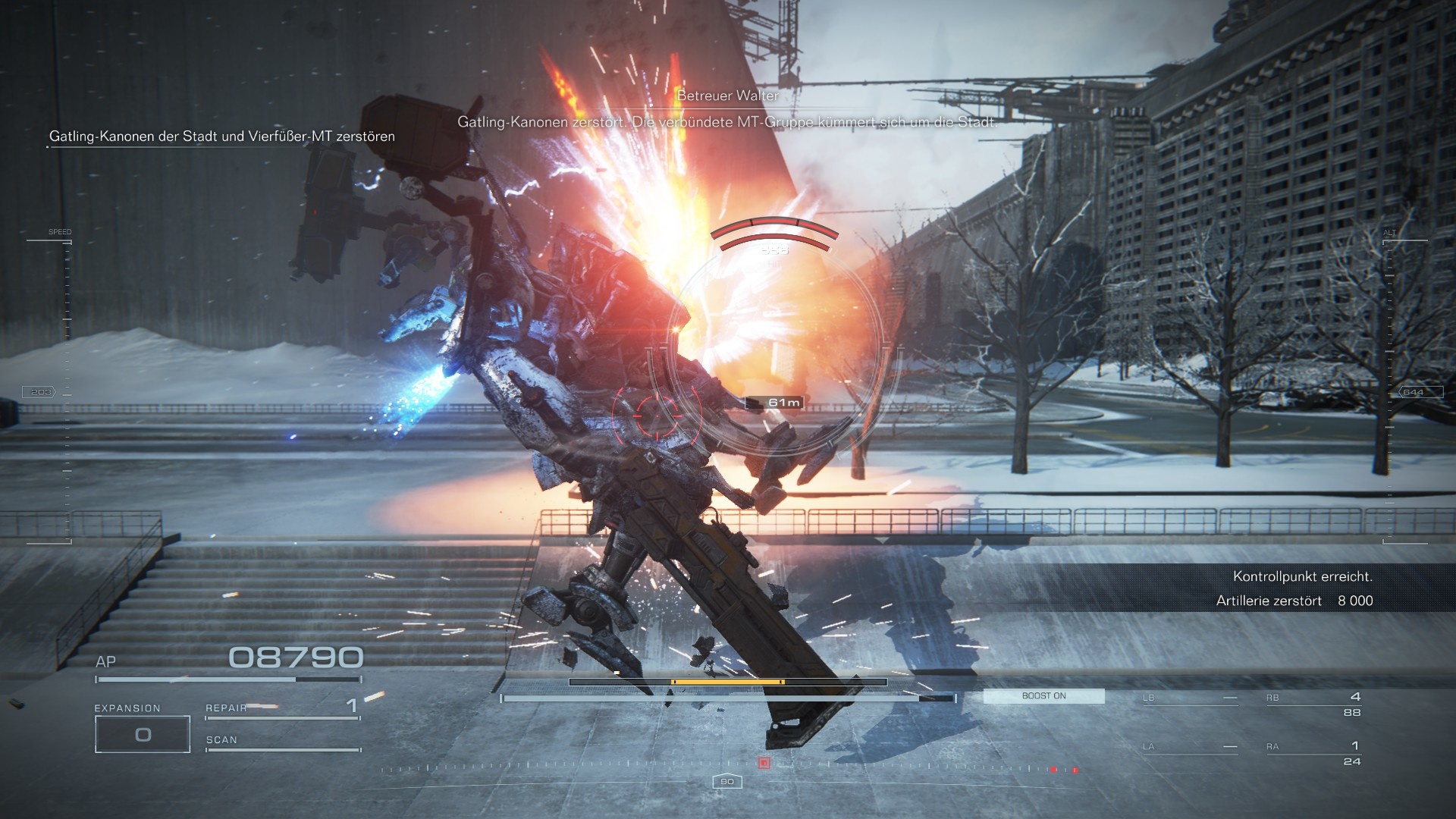
With a boost you can already move faster and also fly as long as your energy is sufficient for it. With a turbo boost, you can shoot through the level for a short moment, but this ability is quickly exhausted. Dodging also costs energy, so you must always keep an eye on the bar in the lower centre of the screen.
However, your learning curve increases rapidly, which is also due to the good introduction of the game. After a short familiarisation period, you’ll have your energy budget under control, fly through canyons and skyscrapers with ease and dodge enemy projectiles in high-speed flight. And there are plenty of them.
Like a Michael Bay movie – only in a good way
The steely heart of Armored Core 6: Fires of Rubicon is without a doubt the action. And even if this consists largely of explosions, it is still surprisingly varied. When the steel and metal of the mechs collide, it has a force that hardly any other game has.
Also in Nier: Automata, Titanfall 2, Metal Gear Solid 4: Guns of the Patriots and especially Zone of the Enders we controlled oversized robots. But the Armored Core series is considered the top dog when it comes to mech action. And FromSoftware once again proves why with the latest instalment.
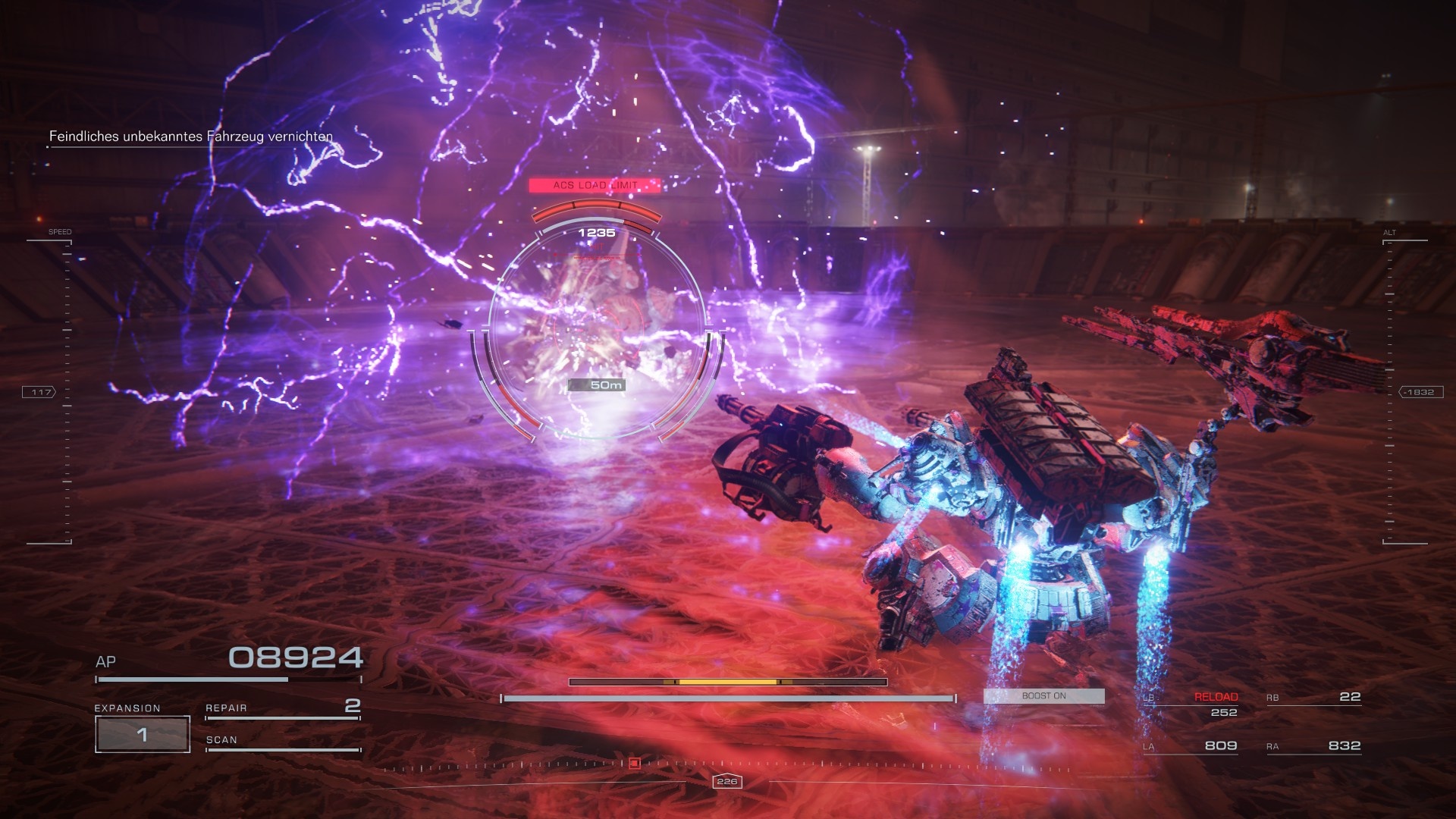
Once your mech enters the battlefield, it’s all adrenaline, explosions and speed. For both arms, you have one weapon each that you can equip. In addition, there are two slots on your back that you can equip freely.
And then there are the special abilities that you will gradually unlock. Impulse armour, for example, makes you much less vulnerable to damage and is ideal for close combat. Storm armour, on the other hand, damages your opponent with a blast wave and must be used aggressively.
But be careful, not every combination is suitable for every opponent. If you have fallen in love with one of the many weapons and can’t get away from it, some enemy types will literally force you to try other weapons.
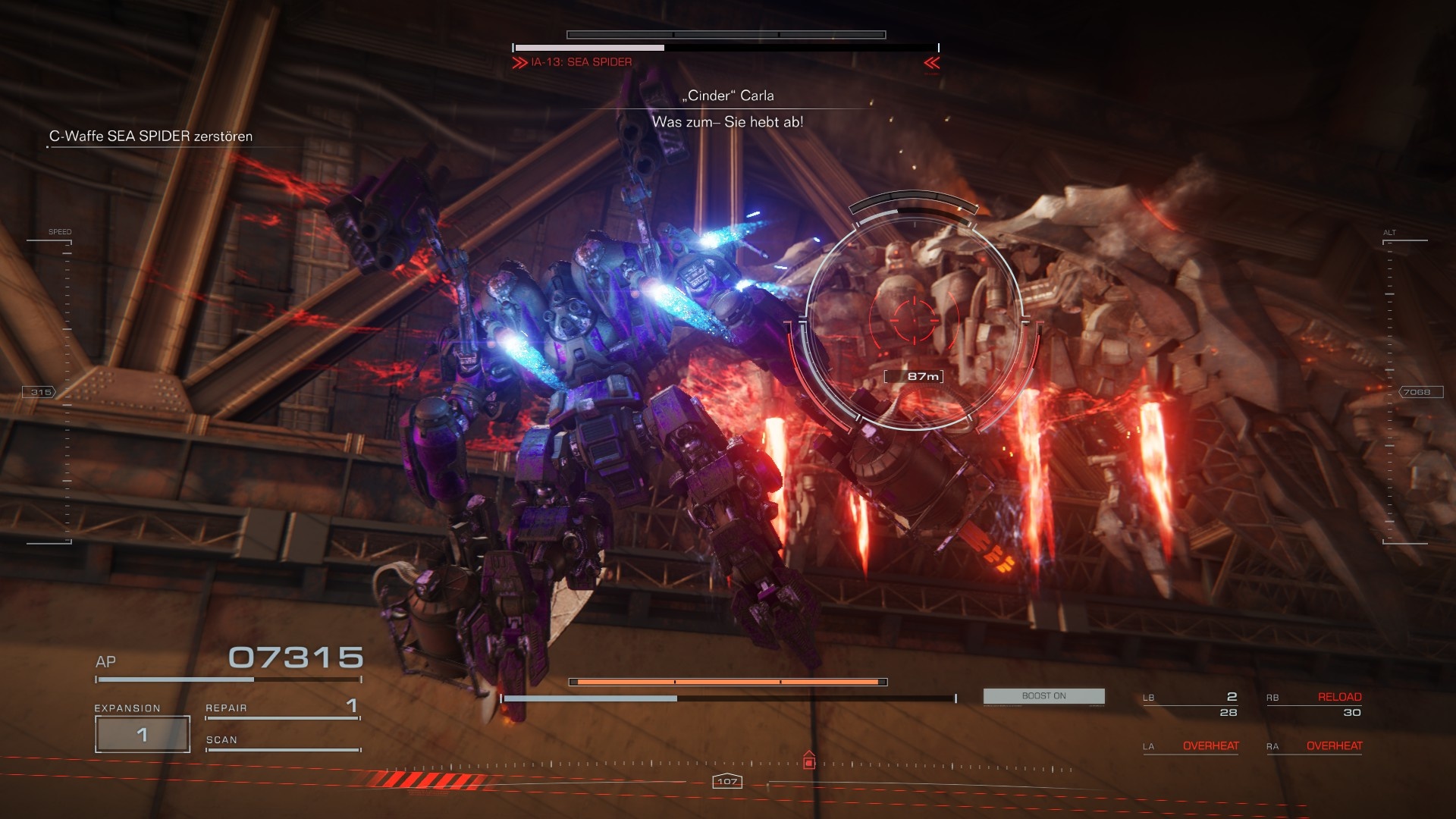
For example, if you quickly approach an enemy and want to deal with him with your blade, he may shoot himself straight up in the air to get away from you. Then again, there are those Armored Cores who themselves seek close combat and charge wildly at you. So you always have to find the right approach and try it out.
If you stubbornly stick to the same choice of weapons, the game will quickly take you to your limits. You have to pay active attention to your enemies, what harms them and what doesn’t, but also what you can equip at all. Because weight and energy requirements play just as important a role in your vehicle as the choice of weapons.
Everything the heart of steel desires
You will first become aware of the large scope of the game when you want to customise your Armored Core in detail. To do this, go to the shop or parts shop. There you can get your weapons and compare the statistics of new parts.
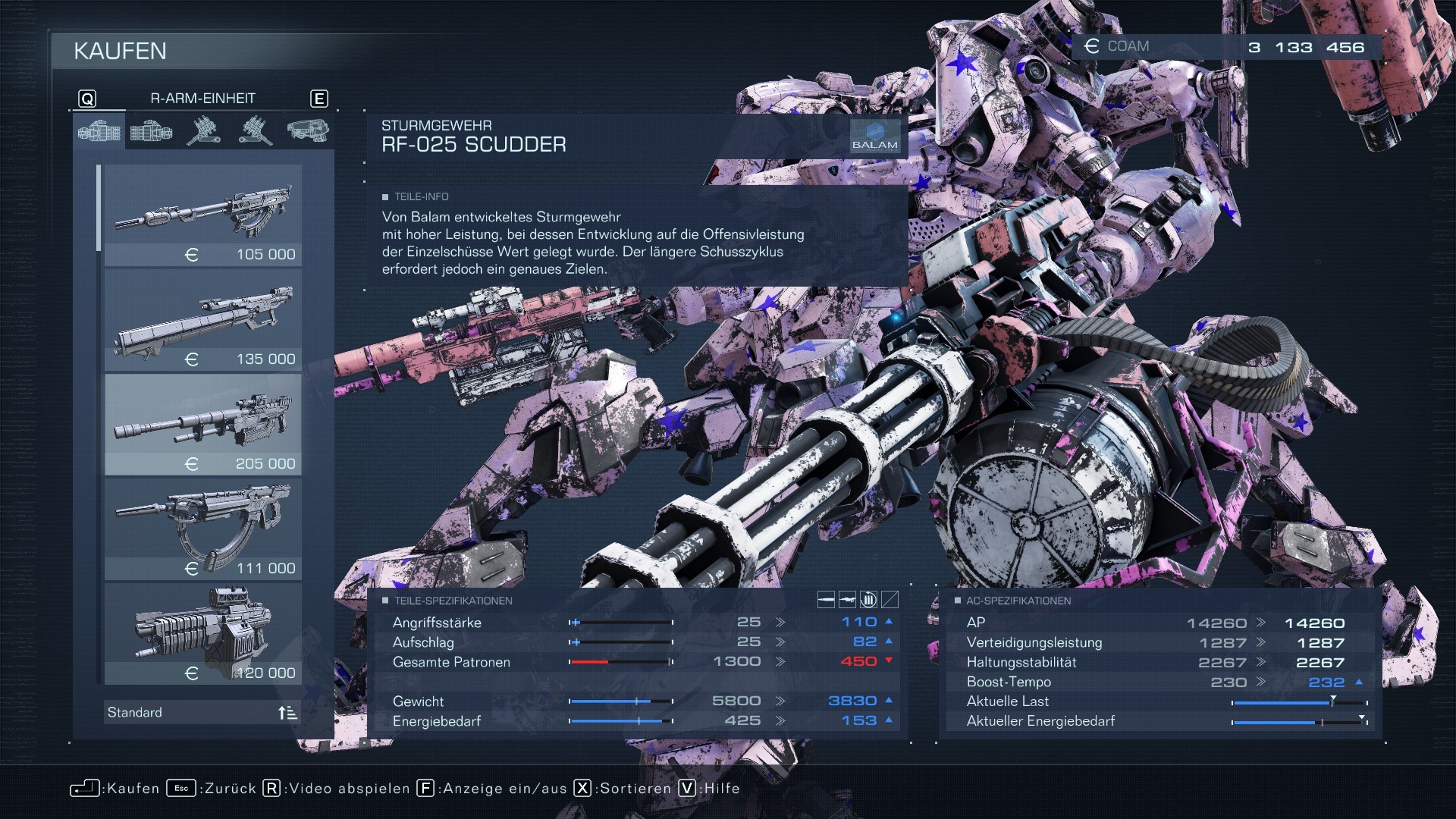
You’ll quickly find yourself suddenly analysing the values of tiny propulsion jets. Then you face the big problem that the new jets make you faster but have a longer regeneration time. And they also make you heavier. The game offers you numerous values that make you weigh up every decision very carefully.
This sometimes results in very abstruse combinations, all of which have their advantages and disadvantages. For example, an Armored Core with four legs has better flight behaviour than other models. If you decide to use the underbelly of a tank, you will be more robust, but also much slower.
The shop’s prices are also worth noting. If you buy a component, you can sell it again for the same price. The stable prices encourage you to try out other weapons and components that you would otherwise never have used. Within a few minutes, you can completely convert your mech from a sniper to a melee fighter, change its appearance and try it out directly on the battlefield.
And that’s not all, the colour editor of Armored Core 6: Fires of Rubicon is in a class of its own. With it, almost anything is possible and you can create the mech of your dreams. Blue steel with yellow eyes and pink weapons? No problem. You want a rusty, weathered mech? Also possible. Or you can cover your machine from top to bottom with stickers and make its metal glitter white with purple stars.
Directly into the fray
Maybe some of you think you need some prior knowledge to play the game, after all it’s the sixth instalment in a long-running series. But FromSoftware appeals to veterans and newcomers alike.
Series veterans will be happy about details or the return of the arena, where they can fight other mechs in duels. Newcomers are thrilled by the action and the many adjustments. And in terms of content, you don’t need to know anything about the series to have fun with the new part. If you want, you can also completely hide the game’s plot.
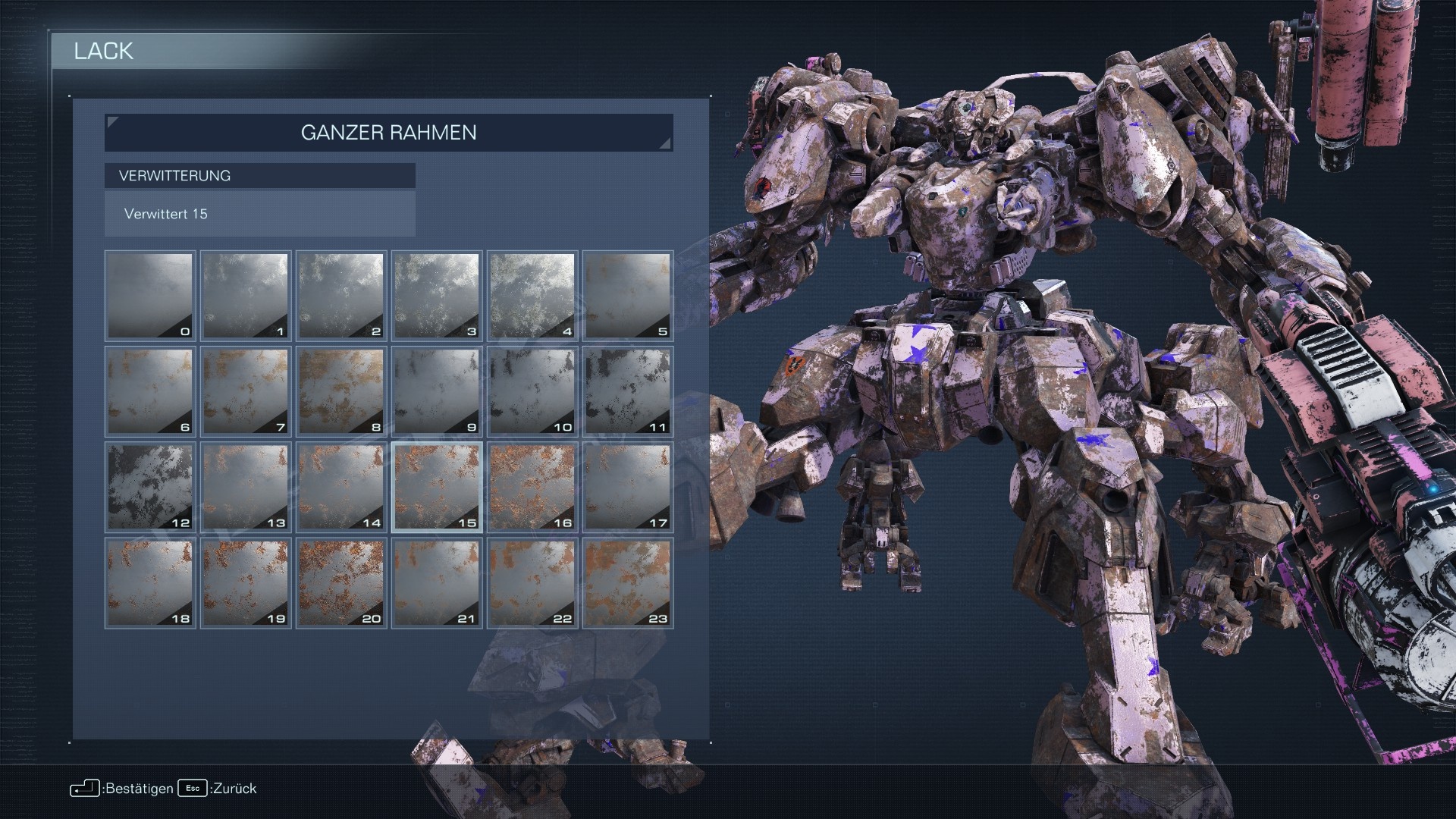
The plot remains in the background and is told after the missions in radio messages or with hidden log books that you can find in the areas. You will have to figure out a lot of things for yourself in order to get more information. You should pay close attention to your radio messages and also to what your enemies say shortly before they die. Reminiscent of Dark Souls, isn’t it?
Samurai in the Mech
In addition, there is a parallel to Sekiro: Shadows Die Twice, more precisely to its battle system. Because as soon as you fight against a strong mech, it is not only a matter of reducing its life bar. With your attacks, you simultaneously charge up another bar above its head until it glows red. This will break the opponent’s cover and he will be staggered for a moment.
This is the moment when you best throw everything at him and cover him with attacks. This gameplay mechanic is very reminiscent of the blocking and counterattacking from Sekiro: Shadows Die Twice. And there is a good reason for this, namely Masaru Yamamura, the game director of Armored Core 6: Fires of Rubicon.
Previously, Yamamura was in charge of the game design for Sekiro: Shadows Die Twice, including the battle system. The Japanese artist also contributed to the design of Bloodborne, and you can quickly tell that his previous experiences inspired the mech combat.
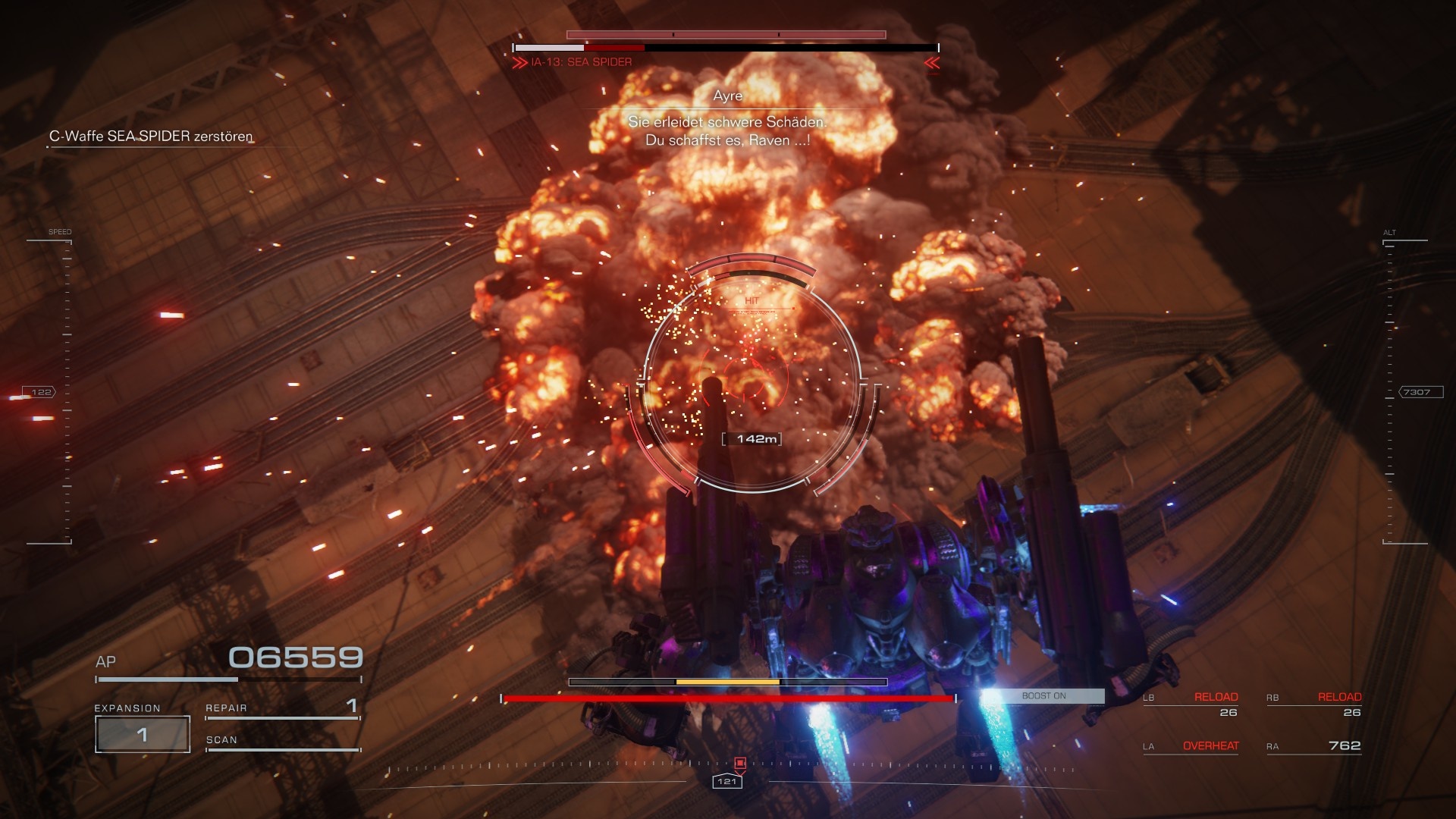
And much like the big bosses of the Souls games, the bosses in this game will break you. At least until you master the mechanics of the game and can use them in quick fights. So the bosses here also function like a kind of litmus test and combine frustration with motivation.
It’s just a pity that it’s only the big enemies that cause you problems. Smaller enemies are hardly worth mentioning and after only a few seconds they go up in an explosion. Even with medium-sized enemies, you can get ahead by shooting everything you have in the way of weapons and rockets at them. The despair is all the greater when you encounter a real enemy.
Sometimes you only get hit because the camera doesn’t want to go your way. It’s actually typical for games from FromSoftware that they have problems with the camera. Although there is an automatic lock-on, you still tend to lose your overview during fast-paced battles and the camera swirls around uncontrollably for a moment. This makes the fights even more difficult than they already are.
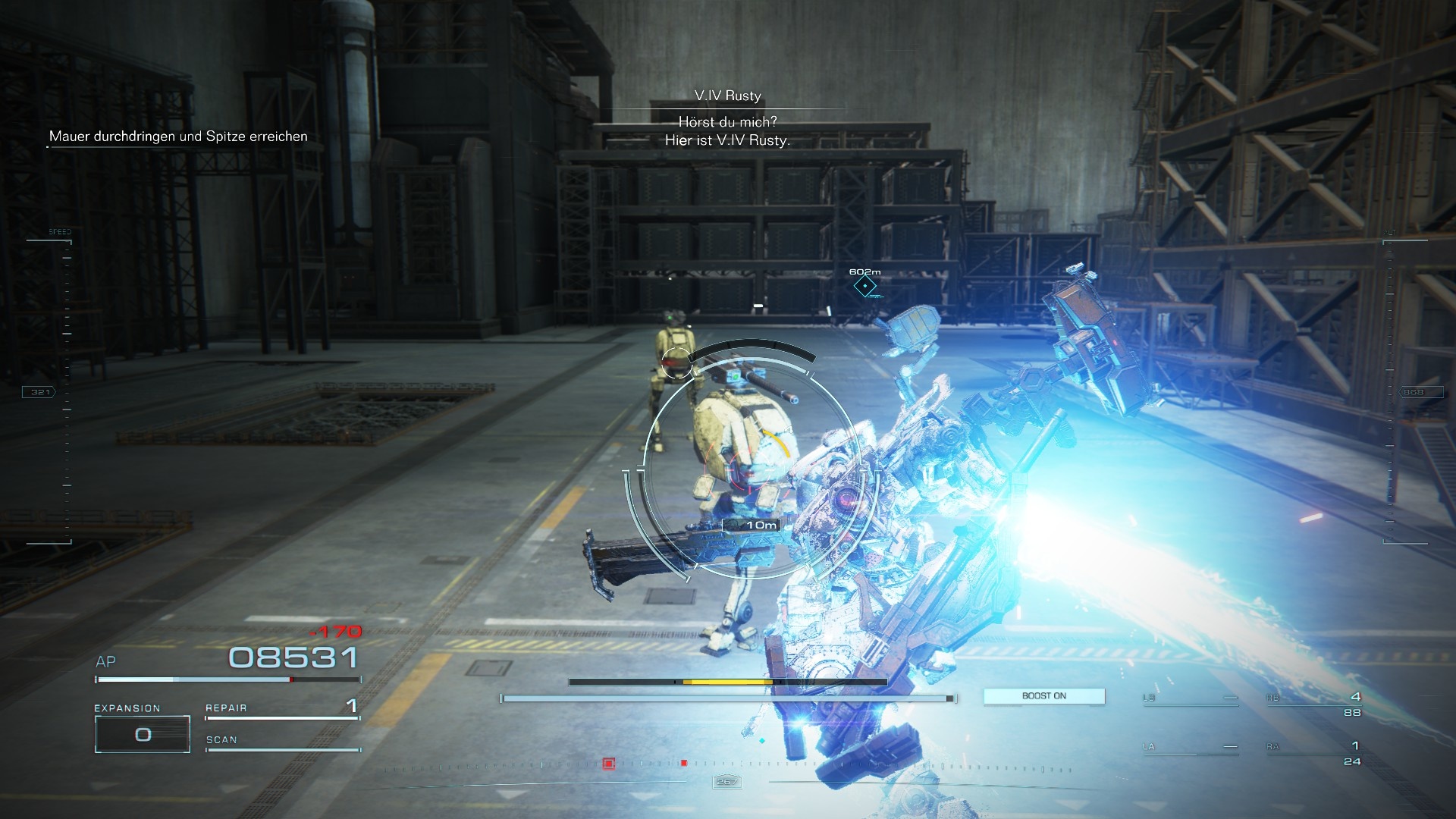
Despite the difficulty, there are much more comfort options here than in most Souls games. Fair checkpoints, especially before bosses, save you the long ways to the boss, as you know them from FromSoftware. However, if you start a mission completely from the beginning, you will lose all checkpoints.
The highlight is a small, but all the more important function: If you want to upgrade your Armored Core because you can’t fight an enemy with your current setup, you don’t have to switch from the mission to the menu first. Instead, you can jump straight into the assembly after dying, make adjustments and return to the battle.
Sand in the gearbox
Although the action is visually impressive with its dynamic particle effects, you shouldn’t expect AAA graphics. Although Armored Core 6: Fires of Rubicon is a consistently pretty game, every now and then the areas look a little too sterile. But you will soon forget this when mechs collide and you experience a flurry of effects in buttery smooth 60 FPS. Now and then there are short frame drops, but you can count them on one hand.
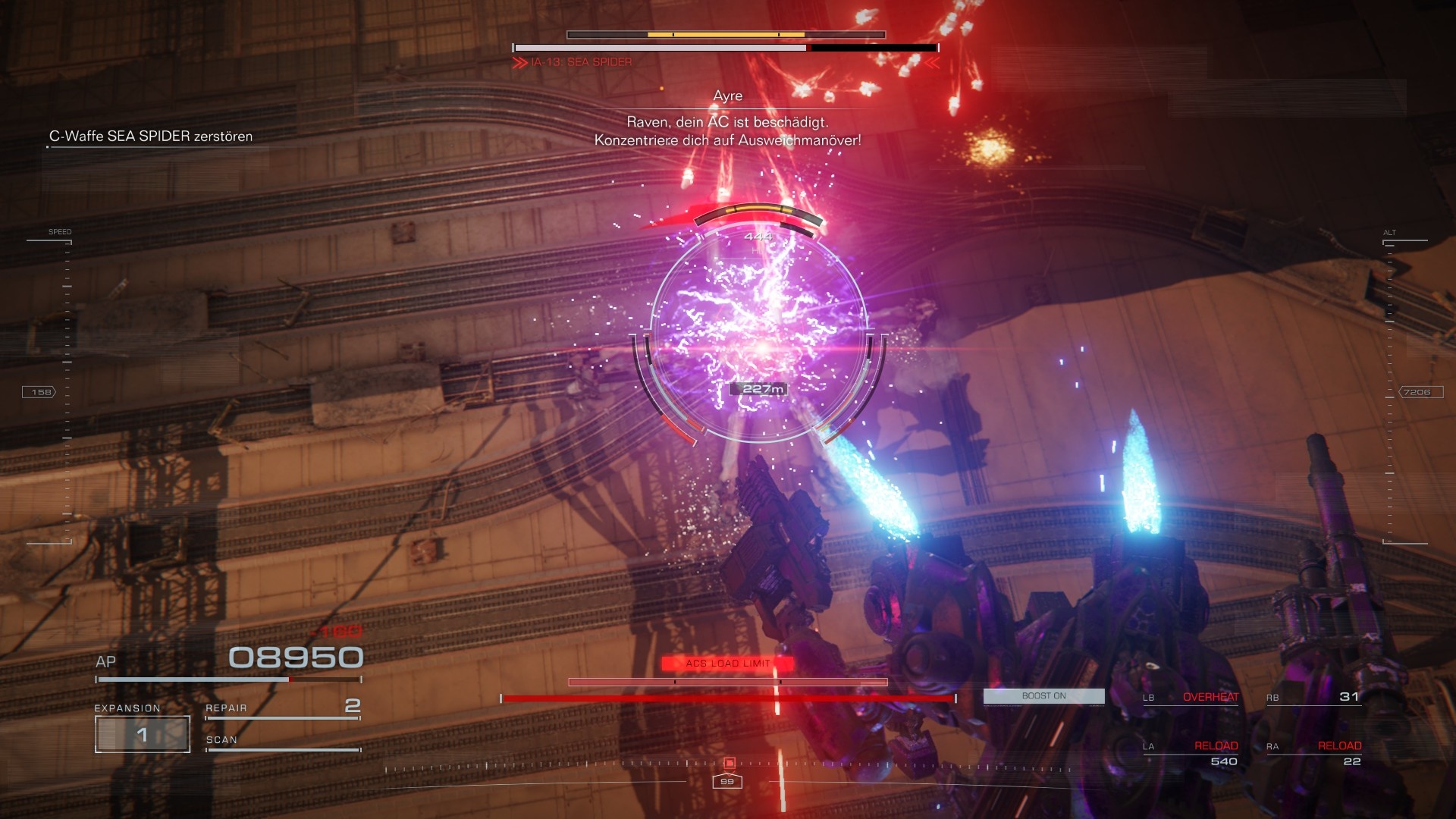
In addition, not only grey industrial areas or residential areas with an Eastern Bloc flair await you. You will run over sand and snow with your mech, fly through deep canyons and over huge battleships, watch a beautiful sunset on the horizon and suddenly find yourself in front of gigantic gears in industrial complexes.
Although the missions all take place in small areas, they are visually all the more varied and will not tire you even if you play through them several times. You will also have to, as the missions often send you to areas you already know.
If you try to explore something off the beaten track, a red border flashes in front of your mech nose, announcing the end of the level. FromSoftware could have solved this in a nicer way.
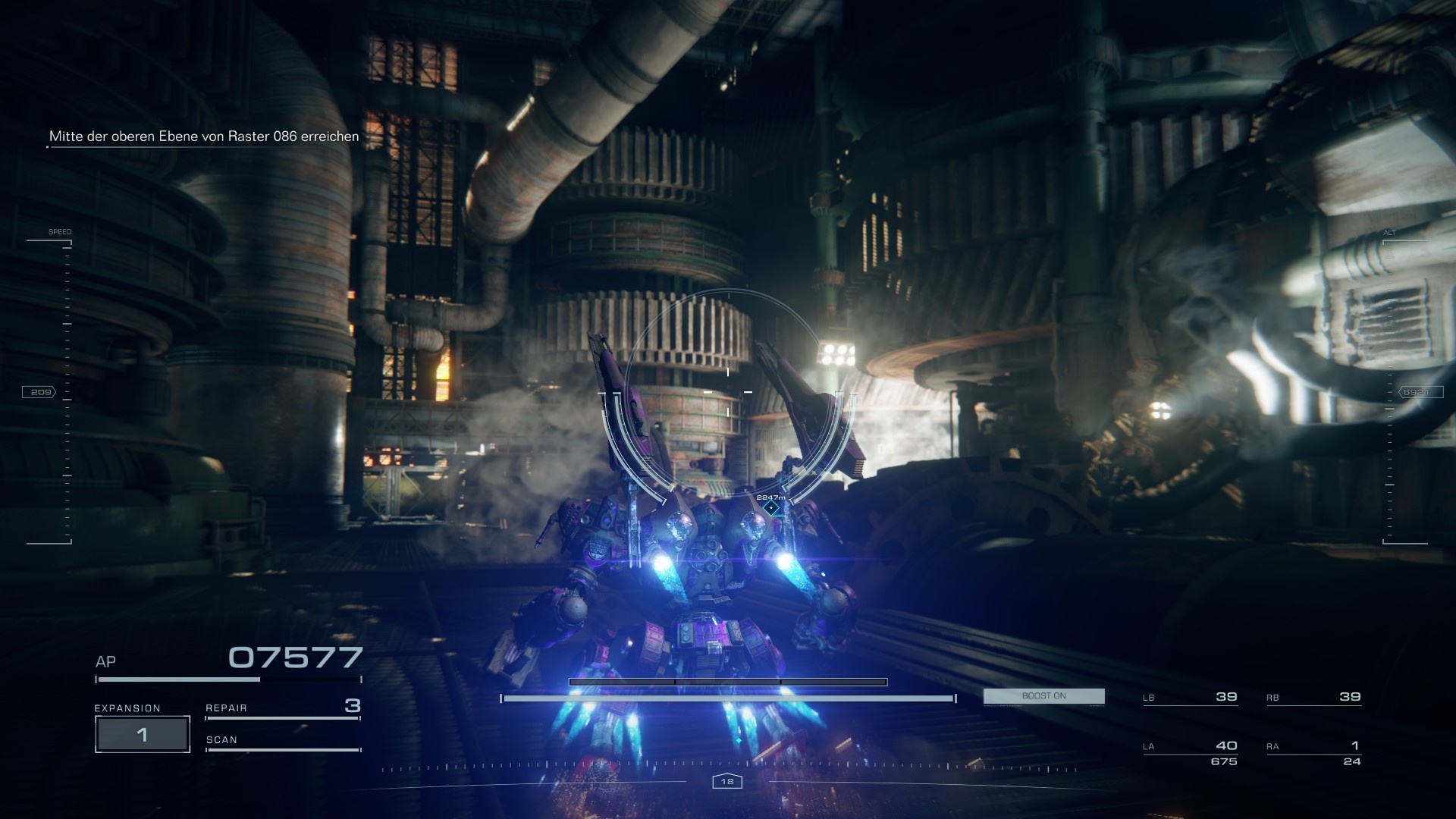
Nevertheless, the missions are great fun and await you with different tasks. Sometimes you have to storm a fortress together with other mercenaries, then again recover a secret document, dodge the fire of a huge cannon or defeat a particularly tough boss.
It shines, flashes and explodes
The sixth main part of the Armored Core series is reminiscent of anime like “Neon Genesis Evangelion” or one of the “Gundam” series. Fans will feel right at home in this game. Mechs are a big part of Japanese pop culture anyway and can be found in many different media.
And FromSoftware shows that they know about the DNA of the almost perfect mech game. Every now and then there are scratches in the paint, but they often get lost in the action. In the words of Neon Genesis Evangelion, the most famous of all mech series, “Get in the robot!”
Editor’s Verdict
As a big fan of anime and Japanese pop culture, I’ve always had a thing for mechs and their stories. However, many of the mech games did not convince me. Often the controls were not direct enough and too bulky for me.
But Armored Core 6: Fires of Rubicon took me by storm. Almost 30 hours later, my Armored Core has become a giant, with weapons almost as big as itself. I’ve laid waste to whole swathes of land with it and fought bosses that have taken everything from me. Typical of FromSoftware, this game also made me swear, but I was rewarded again and again for my playful efforts.
At first I thought the action would tire after a few hours. After tens of hours, I’m still waiting to get my fill of the huge explosions. The many locations and the possibility to build any mech imaginable still keep me in the game.
But I’m tired of discovering the little From Software legacies here too, first and foremost the choppy camera that makes the game experience difficult, especially during fast-paced battles. Nevertheless, I experienced a fantastic battle of material here. Whether you’re a connoisseur of the series or a newbie, everyone should get into this mech. And for the Elden Ring fans among you, there is an enemy that strongly resembles Malenia.

